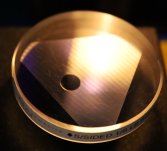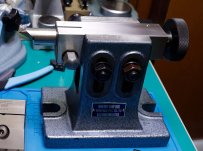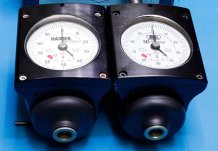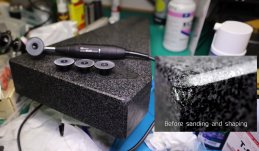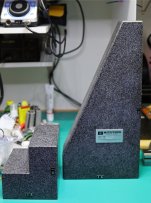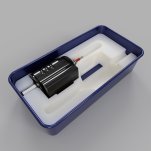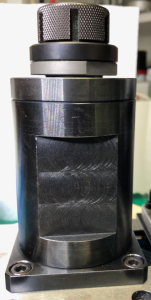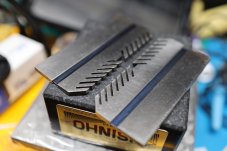So I suspect serendipity has more to do with just paying attention, but as often happens with me, I decide I need a thing, do some research, learn about other things tangentially related to that thing, then those things find their way to my pile of things.

This search started because I was frustrated that the built in vise on the bandsaw I have is about 3 miles (~60mm) from the blade and creates difficulties when I'm trying to cut small parts with it. The cast Iron Makita bed is very well made, but has no coplanar surfaces to clamp to. After having a ton of trouble cutting some very short stock where my large magnetic chuck rescued me, I wasn't crazy about it being in the line of fire of the bandsaw blade, so I was looking for something a little better suited.
I decided what I needed was a magnetic v-block that would be compact enough to fit in the tight quarters of the cutoff area and do a good job of holding small round or flat stock to be cut. This led me to looking at magnetic V-blocks (or drilling and tapping holes in the base so I could clamp some standard ones.) Magnetic V-blocks come in a number of configurations, what I soon realized is I needed one that would simultaneously attract on the top V as well as the bottom so it would self clamp to the cast iron bandsaw base. It didn't initially occur to me, but most of the blocks out there do not actually do this. I think the intention is to have them held by the main chuck or some other fixturing.
Obviously, the more faces of a magnetic block expressing the flux, the less net power per face, and you may want to have some flexibility in how it is fixtured, so it makes sense to limit this. But I identified a good candidate, the
Kanetec KVS-1B and I started looking and found one at a decent price, as with most Japanese tooling the retail pricing is astonishing and costs more than the bandsaw itself.

Switchable magnetic blocks come in all shapes and sizes, but looking at the pictures, even with the dimensions supplied, I wasn't really prepared for how hefty and large this unit actually is, and it's the smaller version. It is clever in that it has different sizes of V on either side, so you have a lot of flexibility. It seems astonishingly powerful, and should do a good job holding little stock, well have to see.
In my search I had also identified what I thought was a much larger unit, a
Kanetec KY(B)-10A which is mounted in a 100㎣ 'Mass Block', a cast iron cube form that is very popular over here. It was cheap and I figured it would make another good scraping project so I ordered it as well, but I was surprised that they are almost the same size!
I had basically been deep diving the Kanetec catalogue ogling all the cool things they made, discovering to my surprise the little hold down clamps in my previous post were actually super expensive. As a poor child I spent a lot of time looking at literature of stuff I could never own, and now that I can afford things,
especially when I see a deal, well...
Long story
short long, one of my sources posted a bunch of items. I have in my head a mental image of an extremely old guy who buys machine salvage very cheaply. He has a
system where he assigns basic ID numbers to the items, he doesn't typically post any model numbers or often even the manufacturers name, so you have to really
know what something is. You just get a blurry photo of a dirty item on the same stained cement floor and some very basic two or three word description. He is leaving so much money on the table, but I think he's getting the stuff so cheap that it just isn't worth his time. Twice before due to this number 'system' he ended up sending me a completely different item that shared the same number. When he got it wrong, he always promptly sent me the correct item, and I got to
keep the wrong ones, not worth a lot, but not nothing, so if anything I always feel a little sorry for him and try to buy his stuff despite the risks.
And as I said, he doesn't clean anything whatsoever, and just throws things loosely in a box with zero internal packing of any kind. Thank god for the tender care of the local shipping companies.
Two of his items looked particularly juicy to me, he had a big Kanetec magnetic chuck that he didn't realize was pictured upside down and a JAM vise mislabeled as 'JMA' so it was not picked up by my saved searches. I asked him for pictures of the top side of the chuck fearing that it was badly damaged and that's why only the bottom was shown, but on seeing the updated photo I bought it immediately.

The reason for his confusion was that it is a
Kanetec RMWH-2F double face chuck, with independent magnets on the top and bottom. I think because of the grime and poor vision he could only make out the large loops on the bottom of the unit, and assumed that was the top (despite the label being upside down), but it cleaned up nicely and had all the original hardware. Perched on top of it is YAJV (yet another JAM vise) a
CSV100 compound sine vise that I have yet to disassemble and deep clean, but is in quite good shape. This vise has two built in sine plates and retails for the ungodly sum of over $5000, but he was listing for $150.
The spacious 150x300mm chuck is designed to throw on a table and self fixture with the independently controlled bottom magnet. I'm uncertain how useful that really will be, but two times the magnets in one unit can't be bad, right?

The top uses their micro-pitch pole design, which is optimized for thinner and smaller items, and it still has the factory surfaces on both sides, so if I ever get a grinder there is still a lot of life and precision left in this thing. ~$3000 new, I got it for $200, about the same price I paid for the smaller
Kanetec RMT-1325 I've been using as a general purpose third hand and for my scraping experiments.

Okay, the last item in our Kanetec deep dive is kind of an oddball as it is non-magnetic. I came across a new indicator stand from them, that I hoped would be useful for transferring squareness for my scraping projects. The
ideal stands for this have a curved front face that you butt against the square (and test object) and that allows you to swivel it to quickly establish the minimum distance to the object so you can compare that value to the measured item.
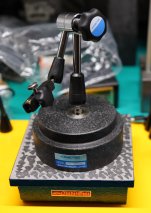
So my hope was that this round granite stand might come in handy for that. It's extremely well made, but only the bottom surface is precision polished, the outer edge is nicely finished, but I'm not sure if it will be effective for what I hoped to use it for. I actually have a squareness transfer tool make by the esoteric
Nishimura Jig, but it relies on a 20mm ceramic rod as its contact surface which is a different approach I'm not completely sold on.

So that's the Kanetec update I promised.




